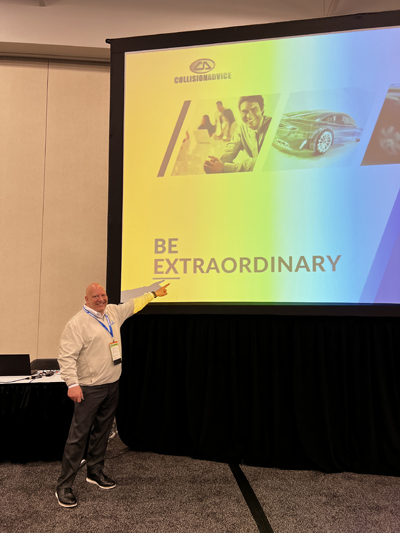Before the pandemic, 36% of accidents occurred outside of 8 a.m. to 5 p.m., according to NHTSA statistics. Since then, Anderson said that percentage has increased to 43%. As a result, he stressed the importance of having a digital presence 24 hours a day, seven days a week, 365 days a year, which includes the company’s online reviews and certifications.
OEM Repair Procedures
Anderson also shared information about connected cars. In 2019, there were nearly 50 million (up from 29 million two years earlier), and 7 in 10 households are expected to have one by 2023, according to Statista and CCC Intelligent Solutions. By year-end, it is anticipated 73.6% of vehicles will be connected through telematics, meaning the OEM will be notified following an accident.
Before a repair, Anderson recommended shops check the OEM procedures to determine if the car is connected and put it in service mode. Otherwise, when it is disassembled, the OEM, the dealership service department and/or customer will likely receive a notification there is a problem.
In Anderson’s experience, the two main reasons shops don’t research OEM procedures are lack of time and knowledge.
“You need to learn how to use technology to give your people back more time,” he advised.
By using technology to conduct tasks such as entering parts invoices, analyzing the VIN and sending texts to customers, Anderson said it provides time for employees to research procedures.
Learning a manufacturer’s safety inspections is also essential.
“Most OEMs, if not all, will have safety inspections for vehicles involved in a collision,” Anderson explained. These include seat belts, steering columns, trim panels, pedals, etc.
As part of a total loss, Anderson reminded shops to remove a driver’s data, including their contact list and garage door code.
Marketing
Anderson recommended shops implement marketing programs at community events such as first responders’ classes, Recycled Rides programs, car club open houses and ladies’ nights out. He also suggests geofencing, which puts an electronic internet fence around specific GPS coordinates. Once a potential customer pulls up the GPS coordinate on the phone, the shop’s ad appears.
For shops becoming EV certified with a charging station, Anderson advised claiming the station and adding a listing on apps like PlugShare.
Cybersecurity
A big concern for insurers, according to Anderson, is cars getting hacked. “If you have an EV charging station where somebody must use their credit card to get the vehicle charged, there are people who can… hack your EV,” he said. He recommended locking down the IT infrastructure and ensuring the data pumps pulling data on the business’s computers aren’t open.
Electric Vehicles
With 30-45% of cars projected to be electric by 2030, Anderson said shops will need to make decisions based on the demographics in their area. The Western U.S. continues to see the highest rates of battery electric vehicle (BEV) adoptions and BEV repairable claim frequency, according to the National Automobile Dealers Association (NADA). Some parts of the country, including the Mountain and Eastern regions, are experiencing a more rapid increase in BEV claim frequency.
“This suggests that the trend is expanding across the country, especially as charging infrastructure becomes more prevalent,” Anderson noted.
He said EVs will do what aluminum did not---separate the shops.
“Lack of knowledge on an EV will not only hurt the vehicle, but it can also kill you,” he shared.
He encouraged shops to learn when to remove the high-voltage battery, the ideal storage area, how to monitor and check it, and fire suppression.
Growing a Team
Since the pandemic, Anderson said there are fewer people doing more work. Nearly 80,000 collision technicians are needed between 2020-2024, according to the TechForce Foundation in 2020. He advised shops to grow their teams by participating in programs such as the Collision Engineering Program, powered by the Enterprise Rent-A-Car Foundation and Ranken Technical College.
The program was designed to attract and develop entry-level talent for the collision industry and enhance the retention and advancement of technicians.
With the industry competing with employers like Amazon, Anderson recommended building a culture, evaluating how technicians are paid and the benefits offered, including flexible work schedules and career paths.
“I don’t believe in stealing fish from another man’s pond,” said Anderson. “We need to recruit by offering a more competitive compensation package.”










Stacey Phillips Ronak